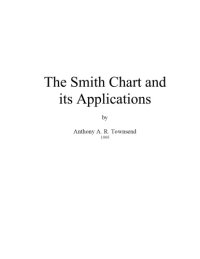- Genre: Technique // Electronics
- Tags: Charts diagrams etc, Electric conductors, Electric lines, Electric measurements, Electric power transmission, Electric resistance, Electromagnetic waves -- Transmission, Electronics, Impedance (Electricity), Impedance matching, charts, conductors (electric), electric admittance, electric impedance measurement, electromagnetic wave propagation, electronic engineering, impedance matching, negative resistance, transmission lines, Smith Chart, electronic applications, electromagnetic wave propagation, normalized impeda
- Year: 1995
- Publisher: SciTech Publishing
- City: Raleigh, NC
- Edition: 2nd ed.
- Language: English
-
pdf
The purpose of this book is to provide a comprehensive and practical source volume on Smith Charts and their related overlays. Qualitative concepts of the way in which electromagnetic waves are propagated along conductors are given in chapter 1. This is followed in chapters 2 and 3 by an explanation of how these concepts are related to their quantitative representation on the 'normalized' impedance coordinates of the Smith Chart. Chapters 4 and 5 describe the radial and peripheral scales of this chart, which show, respectively, the magnitudes and angles of various linear and complex parameters which are related to the impedance coordinates of the chart. In chapter 6 an explanation is given of equivalent circuit representations of impedance and admittance on the chart coordinates. Several uses of expanded portions of the chart coordinates are described in chapter 7, including the graphical determination there from of bandwidth and Q of resonant and antiresonant line sections. The complex transmission coefficients, their representations on the Smith Chart, and their uses form the subject of chapter 8. Impedance matching by means of single and double stubs, by single and double slugs, and by lumped L-circuits is described in chapters 9 and 10. The measurement of impedance by sampling voltage or current along the line at discrete positions, where a slotted line section would be excessively long, is described in chapter 11. The effect of negative resistance loads on transmission lines, and the construction and use of the negative Smith Chart and its special radial scales, are described in chapter 12. Chapter 13 discusses, with examples, a number of typical applications of the chart. Chapter 14 describes several instruments which incorporate Smith Charts as a basic component, or which are used with Smith Charts to assist in plotting data thereon or in interpreting data therefrom. Read more...
